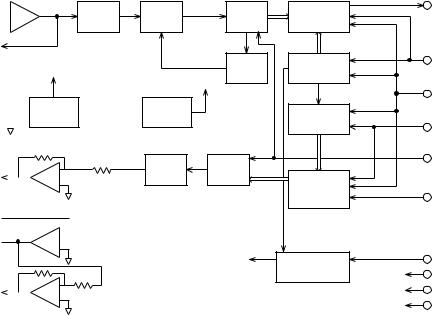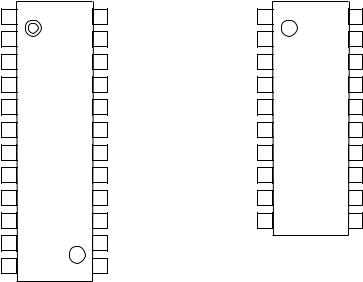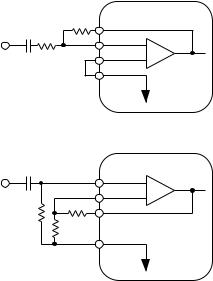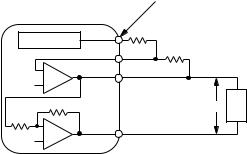OKI ML7000-02MA, ML7000-02MB, ML7000-01MA, ML7001-03MB, ML7001-01MA Datasheet
...
E2U0062-18-84 |
|
Preliminary |
¡ Semiconductor |
||
Semiconductor |
|
This version: Aug. 1998 |
ML7000-01/02/03/ML7001-01/02/03 |
||
ML7000-01/02/03
ML7001-01/02/03
Single Rail CODEC
GENERAL DESCRIPTION
The ML7000/ML7001 are single-channel CMOS CODEC LSI devices for voice signals ranging from 300 to 3400 Hz with filters for A/D and D/A conversion.
Designed especially for a single-power supply and low-power applications, the devices are optimized for ISDN terminals, digital wireless systems, and digital PBXs.
The devices use the same transmission clocks as those used in the MSM7507.
With the differential analog signal outputs which can drive 60 W load, the devices can directly drive a handset receiver.
FEATURES
• Single power supply: +5 V (ML7000-xx)
|
+3 V (ML7001-xx) |
|
• Low power consumption |
|
|
Operating mode: |
25 mW Typ. |
VDD = 5.0 V (ML7000-xx) |
|
20 mW Typ. |
VDD = 3.0 V (ML7001-xx) |
Power-down mode: |
0.05 mW Typ. |
VDD = 5.0 V (ML7000-xx) |
0.03mW Typ. VDD = 3.0 V (ML7001-xx)
•Conforms to ITU-T Companding law
ML7000-01/ML7001-01: m/A-law pin selectable
ML7000-02/ML7001-02: m-law
ML7000-03/ML7001-03: A-law
•Transmission characteristics conform to ITU-T G.714
•Short frame sync timing operation
•Built-in PLL eliminates a master clock
•Serial data rate: 64/96/128/192/200/256/384/512/
768/1024/1536/1544/2048 kHz
•Adjustable transmit gain
•Adjustable receive gain
•Built-in reference voltage supply
•Package options:
24-pin plastic SOP (SOP24-P-430-1.27-K) (Product name: ML7000-01MA/ML7001-01MA)
(Product name: ML7000-02MA/ML7001-02MA) (Product name: ML7000-03MA/ML7001-03MA)
20-pin plastic SSOP (SSOP20-P-250-0.95-K) (Product name: ML7000-01MB/ML7001-01MB) (Product name: ML7000-02MB/ML7001-02MB) (Product name: ML7000-03MB/ML7001-03MB)
1/19

¡ Semiconductor |
ML7000-01/02/03/ML7001-01/02/03 |
BLOCK DIAGRAM
AIN–  –
–
AIN+  +
+
GSX 
SGC  SG
SG 

VFRO 

PWI 
AOUT– 
AOUT+ 

SG
GEN
–
+
–
+
–
+
RC |
8th |
A/D |
TCONT |
PCMOUT |
LPF |
BPF |
CONV. |
|
|
|
|
|||
|
|
AUTO |
PLL |
XSYNC |
|
|
ZERO |
|
|
|
|
|
|
|
|
VR |
|
|
BCLK |
|
|
|
|
|
|
GEN |
|
RTIM |
RSYNC |
|
|
|
|
|
|
5th |
D/A |
|
(ALAW) |
|
|
|
||
|
LPF |
CONV. |
RCONT |
|
|
|
|
PCMIN |
|
|
|
|
|
|
|
|
PWD |
PWD |
PDN |
|
|
|
Logic |
VDD |
|
|
|
|
AG |
|
|
|
|
DG |
2/19

¡ Semiconductor |
ML7000-01/02/03/ML7001-01/02/03 |
PIN CONFIGURATION (TOP VIEW)
SG |
1 |
24 |
SGC |
SG |
1 |
20 |
SGC |
AOUT+ |
2 |
23 |
AIN+ |
AOUT+ |
2 |
19 |
AIN+ |
AOUT– |
3 |
22 |
AIN– |
AOUT– |
3 |
18 |
AIN– |
NC |
4 |
21 |
GSX |
PWI |
4 |
17 |
GSX |
PWI |
5 |
20 |
NC |
VFRO |
5 |
16 |
NC |
VFRO |
6 |
19 |
NC |
VDD |
6 |
15 |
(ALAW)* |
NC |
7 |
18 |
(ALAW)* |
DG |
7 |
14 |
AG |
VDD |
8 |
17 |
NC |
PDN |
8 |
13 |
BCLK |
DG |
9 |
16 |
AG |
RSYNC |
9 |
12 |
XSYNC |
PDN 10 |
15 |
BCLK |
PCMIN 10 |
11 |
PCMOUT |
||
RSYNC 11 |
14 |
XSYNC |
|
20-Pin Plastic SSOP |
|
||
PCMIN 12 |
13 |
PCMOUT |
|
|
|||
|
|
|
|
||||
24-Pin Plastic SOP
*The ALAW pin is only supported by the ML7000-01MA/ML7000-01MB/ML7001-01MA/ ML7001-01MB.
NC : No connect pin
3/19

¡ Semiconductor |
ML7000-01/02/03/ML7001-01/02/03 |
PIN FUNCTIONAL DESCRIPTION
AIN+, AIN–, GSX
Transmit analog input and transmit level adjustment.
AIN+ is a non-inverting input to the op-amp; AIN– is an inverting input to the op-amp; GSX is connected to the output of the op-amp.
The level adjustment should be performed using any of the methods shown below. During power-saving and power-down modes, the GSX output is at AG voltage.
|
C1 |
|
GSX |
|
R1 : variable |
|
Analog input |
R2 |
AIN– |
– |
R2 > 20 kW |
|
|
|
|
|||||
|
|
AIN+ |
C1 > 1/(2 ¥ 3.14 |
¥ 30 ¥ R1) |
||
|
|
R1 |
+ |
|||
|
|
SG |
|
|
||
|
|
|
|
|
|
C2 |
|
AIN+ |
+ |
R3 > 20 kW |
Analog input |
|
AIN– |
R4 > 20 kW |
|
|
|
– |
||
|
|
GSX |
R5 > 50 kW |
|
R5 |
|
|
||
R4 |
|
|
C2 > 1/ (2 ¥ 3.14 ¥ 30 ¥ R5) |
|
|
R3 |
SG |
|
|
AG
Analog ground.
VFRO
Receive filter output.
The output signal has an amplitude of 2.4 VPP for ML7000-xx and 2.0 VPP for ML7001-xx above and below the signal ground voltage (SG) when the digital signal of +3 dBm0 is input to PCMIN and can drive a load of 20 kW or more.
For driving a load of less than 20 kW, connect a resistor of 20 kW or more between the pins VFRO and PWI.
During power-saving or power-down mode, the VFRO output is at an SG level.
When adjusting the receive signal on the basis of frequency characteristics, refer to the Frequency Characteristics Adjustment Circuit.
4/19

¡ Semiconductor |
ML7000-01/02/03/ML7001-01/02/03 |
PWI, AOUT+, AOUT–
PWI is connected to the inverting input of the receive driver.
The receive driver output is connected to the AOUT– pin. Therefore, the receive level can be adjusted with the pins VFRO, PWI, and AOUT–. During power-saving or power down-mode, the outputs of AOUT+ and AOUT– are in a high impedance state. The output of AOUT+ is inverted with respect to the output of AOUT–. Since these outputs provide differential drive of an impedance of 1.2 kW, they can directly be connected to a handset using a piezoelectric earphone or a line transformer. Refer to the application example.
|
|
|
VI |
|
Receive filter |
VFRO |
R6 |
|
R6 > 20 kW |
|
|
ZL > 1.2 kW |
||
PWI |
|
R7 |
||
|
|
|
||
|
|
|
|
–AOUT–
SG |
+ |
|
Gain = VO/VI = 2 5 R7/R6 £ 2 |
|
|
|
|
20 kW – |
20 kW |
VO ZL |
|
AOUT+ |
|
||
SG |
+ |
|
|
|
|
|
|
VDD
Power supply for +5 V (ML7000-xx) or +3 V (ML7001-xx)
PCMIN
PCM data input.
A serial PCM data input to this pin is converted to an analog signal in synchronization with the RSYNC signal and BCLK signal.
The data rate of PCM is equal to the frequency of the BCLK signal.
PCM signal is shifted in at the falling edge of the BCLK signal and latched into the internal register when shifted by eight bits.
The start of the PCM data (MSD) is identified at the rising edge of RSYNC.
BCLK
Shift clock signal input for the PCMIN and PCMOUT signals.
The frequency, equal to the data rate, is 64, 96, 128, 192, 256, 384, 512, 768, 1024, 1536, 1544, or 2048 kHz. Setting this signal to logic "1" or "0" drives both transmit and receive circuits to the power saving state.
5/19
¡ Semiconductor |
ML7000-01/02/03/ML7001-01/02/03 |
RSYNC
Receive synchronizing signal input.
Eight required bits are selected from serial PCM signals on the PCMIN pin by the receive synchronizing signal.
Signals in the receive section are synchronized by this synchronizing signal. This signal must be synchronized in phase with the BCLK. The frequency should be 8 kHz ±50 ppm to guarantee the AC characteristics which are mainly the frequency characteristics of the receive section.
However, if the frequency characteristic of an applied system is not specified exactly, this device can operate in the range of 6 to 9 kHz, but the electrical characteristics in this specification are not guaranteed.
XSYNC
Transmit synchronizing signal input.
The PCM output signal from the PCMOUT pin is output in synchronization with this signal. This synchronizing signal triggers the PLL and synchronizes all timing signals of the transmit section. This synchronizing signal must be synchronized in phase with BCLK.
The frequency should be 8 kHz ±50 ppm to guarantee the AC characteristics which are mainly the frequency characteristics of the transmit section. However, if the frequency characteristic of an applied system is not specified exactly, this device operates in the range of 6 to 9 kHz, but the electrical characteristics in this specification are not guaranteed.
Setting this signal to logic "1" or "0" drives both transmit and receive circuits to the power saving state.
6/19
